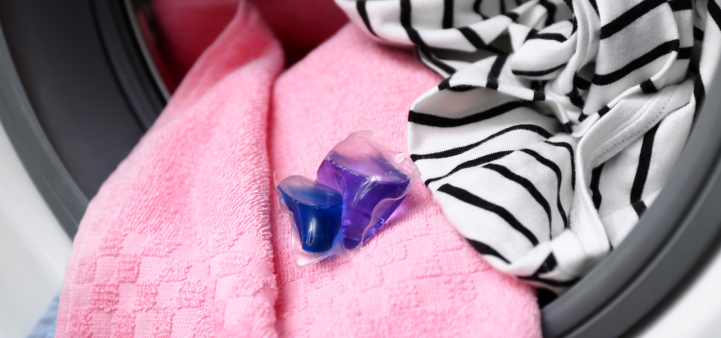
You may have heard about a proposed bill in New York City that would restrict the use of polyvinyl alcohol, (also known as PVA or PVOH), a water-soluble polymer used to make sustainable laundry and automatic dishwasher detergent packets. This legislation is due to a campaign launched by the company Blueland to discredit polyvinyl alcohol use in detergents, despite decades of proof on safe use. We're diving into the science to separate myth from fact.

Blueland Myth

In Reality...
While polyvinyl alcohol – known as PVA – [used in liquid laundry and dishwasher detergent packets or pods] may dissolve in water into smaller pieces that may not be readily visible, it does not actually disappear. Instead, these smaller plastic particles persist in our environment as microplastics and nanoplastics.

MISLEADING: To make this claim, Blueland looked at insoluble grades of PVA and other materials that are not the grade used for detergents. To the contrary, the grade of PVA used for detergents is specially designed to dissolve completely and biodegrades within hours in wastewater treatment. It’s also been proven to biodegrade in river water. There is zero scientific evidence that the grade of PVA used for detergents becomes microplastics.


Research shows that ~75% of intact plastic particles from laundry detergent pods are released into our oceans, rivers and soil (International Journal of Environmental Research and Public Health, 2021). Why? Because the conditions needed to completely degrade this plastic are extremely specific and don’t exist in most [or] all wastewater treatment plants or the natural environment.

THIS CLAIM WAS ALREADY REJECTED BY EPA SCIENTISTS because it is based on flawed calculations and assumptions. In refuting this claim, the EPA published a detailed, point-by-point rejection, concluding that the journal article cited in the Blueland petition [Rolsky and Kelkar] referenced data on true microplastics - not the water-soluble grade of PVA - and failed to acknowledge the substantial amount of existing biodegradation and safety data on water soluble PVA.


Once PVA is released into wastewater, it has the potential to adsorb dangerous chemicals and contaminants, antibiotics, and heavy metals and work its way back up our food chain.

FALSE: The grade of PVA used for laundry detergents dissolves completely and biodegrades within hours of wastewater treatment, making it impossible for it to accumulate in other materials. There is nothing left for other materials to affix themselves to. EPA has verified this through decades of scientific research on the lack of toxicity of PVA.


PVA has recently been found among other microplastics in drinking water drawn from a public drinking fountain in Mexico.

FALSE: The study cited as evidence of PVA in drinking water incorrectly characterized a sample as PVA when the data (from a spectrograph) much more closely matches cellulose.


PVA has recently been found among other microplastics in human breastmilk.

MISLEADING: The study cited to support this claim for human breast milk found one PVA particle in 34 samples. That particle was brown in color, whereas PVA designed for detergent films is clear. An analysis of the study data (from a spectrograph) showed that the identified particle displayed characteristics inconsistent with the highly soluble grade used to make detergent packets. Moreover, PVA is approved by the U.S. Food and Drug Administration (FDA) for safe use in a range of food, medicine and agricultural products that are ingested by people every day, which were not controlled for in the study. Additionally, the study concluded that it would be impossible to identify the particle source.


When you toss a laundry pod into your washing machine, the plastic goes down our drains and pollutes our environment. While PVA might not be visible to the human eye, it’s still contributing to our current plastic crisis at a massive scale.

THIS CLAIM ALREADY REJECTED BY EPA SCIENTISTS: The PVA used in unit dose laundry products is water soluble and biodegrades in wastewater treatment plants (WWTPs) and the environment. This fact is confirmed by the EPA: https://www.regulations.gov/document/EPA-HQ-OPPT-2022-0923-0001
More than 50 years of published science and extensive reviews by regulatory agencies from around the world have supported the safety of PVA for use in diverse industries, including food, medicine and agriculture.


An estimated 20 billion pods are sent down our drains into our water each year in the U.S. alone. However, all companies – conventional and natural – that sell pods or sheets come individually wrapped in PVA, a synthetic, petroleum-based plastic film. As one of the most widely used cleaning formats, plastic pods have the potential to become a ubiquitous pollutant in the future if not immediately stopped.

FALSE: Data exists in the published and peer reviewed literature that PVA dissolves and biodegrades in wastewater treatment plants and the environment. Similar data exists for polyethylene glycol, a synthetic, petroleum-based polymer utilized by Blueland: https://www.blueland.com/articles/understanding-the-blueland-ingredients-label


While PVA may dissolve in water into smaller pieces that may not be readily visible, it does not actually disappear. Instead, these smaller plastic particles persist in our environment as microplastics and nanoplastics. PVA is one of the most ubiquitous wastewater pollutants in the U.S.

FALSE: To the contrary, peer reviewed journal articles demonstrate that this grade of PVA is degraded in wastewater treatment plants and the environment.
There is zero scientific evidence that the grade of PVA used for detergents becomes microplastics.


PVA is a plastic that is not readily biodegradable and persists, polluting our environment and contaminating our water. The plastic particles from pods go down the drain into our water systems and to wastewater treatment plants (WWTPs) that do not have the ability to biodegrade PVA. Research estimates that ~75% of intact plastic particles from laundry detergent pods are released into our oceans, rivers, and soil.

FALSE: The research cited here did not prove anything because the researchers did not perform any tests. Instead, they cherrypicked data from unrelated studies to develop a hypothetical model to produce a thoroughly inaccurate estimate.
The EPA, which has the authority and necessary scientific expertise to regulate cleaning product chemistries, has already explicitly and definitively rejected these claims.
Additionally, the study did not use EPA’s own guidance on how to scale degradation rates from laboratory-based studies to modeling of full-scale wastewater treatment plant operations. The study had several very arbitrary unfounded assumptions compounded by basic math problems: for example, 34 billion gallons of water being treated per day across 16,000 WWTPs yields 2.12 million gallons daily per facility while the study claims 2.21 billion gallons daily per facility (erring by a factor of 1000 times).


Once PVA is released into wastewater, it has the potential to adsorb dangerous chemicals and contaminants, antibiotics, and heavy metals and work its way back up our food chain. In a recent study, PVA was found to have the highest adsorption capacity for lead and cadmium of all of the microplastics studied. Compounds such as biocides, insecticides, herbicides, flame retardants, heavy metals, antibiotics and pharmaceuticals are present in wastewater. Some of these are proven carcinogens, and PVA could act as a vector for transport up the food chain.
PVA has recently been found among other microplastics in drinking water and human breast milk. PVA has also been shown to significantly impact fish health, including growth rate, metabolic rate and ability to fight infection. While there is not yet any research on PVA impact to human health, PVA is concerning given its very measurable impact on fish health, as well as its proven ability to act as carriers for toxins like lead and cadmium.

MISLEADING: The paper stating that PVA adsorbs lead and cadmium was done on solid, insoluble particles of PVA that are entirely different from those used in detergents.
The grade of PVA used for laundry detergents dissolves completely in and biodegrades within hours of wastewater treatment, making it impossible for it to accumulate other materials. There is nothing left for other materials to affix themselves to.
Furthermore, PVA is approved by the FDA for safe use in a range of food, medicine and agricultural products that are ingested by people every day. The study cited here concluded that it would be impossible to identify the source and making the link to detergent products is far-fetched.


Taking plastic pods and sheets off the market will not make it more expensive or inaccessible for consumers. There are many alternative formats, including liquid, powder and tablet detergents, which are not only more widely available and used, but also more affordable than pods.

FALSE: Consumers shouldn’t need to choose between sustainability, price or performance. That’s why the PVA in detergents was designed to meet the strictest environmental standards. In addition to biodegrading quickly, PVA allows the product to be compact, highly concentrated and have a lower carbon footprint. In fact, the biggest environmental opportunity in laundry is moving from hot to cold water washing, which is enabled by PVA’s ability to fully dissolve even in cold temperatures.


PVA has been shown to measurably impact fish health, including growth rate, metabolic rate and ability to fight infection. There is not yet any research on PVA impact to human health, but it is concerning given its impact on fish. PVA’s proven ability to act as carriers to other toxins like cadmium and lead is also concerning given PVA has many opportunities to adsorb harmful substances as it spends time in wastewater and the environment.

MISLEADING: The work referenced was done on a grade of PVA that is NOT water soluble and considered a microplastic. The grade of PVA used in laundry unit dose films, pharmaceuticals and food is soluble and the environmental safety (algae, daphnia, and fish) and mammalian safety has been confirmed by EPA, FDA and other agencies around the world.


The lab testing methods that have been relied on to substantiate biodegradability (the OECD series) are specifically designed and optimized to support degradation of PVA and are vastly different from the conditions that actually exist in most all wastewater treatment plants. For example, very specific microbes need to be present to degrade PVA, but these microbes simply don’t exist at most all WWTPs or in the natural environment. PVA needs to be exposed to these microbes for 28+ days (vs. the 2-3 days that PVA/water typically spends in a WWTP).

FALSE: The US EPA evaluated these claims asserted by researchers Rolsky and Kelkar and found them to be factually incorrect. This is pointed out in the EPA’s response to Blueland’s Petition to EPA: “[T]he OECD biodegradation test conditions are more conservative than real world conditions in WWTPs and are appropriate tools for predicting biodegradation of PVA.” https://www.regulations.gov/document/EPA-HQ-OPPT-2022-0923-0001
Sources
- Biodegradability of Polyvinyl Alcohol Based Film Used for Liquid Detergent Capsules, D. Byrne, G. Boeije, I. Croft, G. Huttmann, G. Luijkx, F. Meier, Y Parulekar, and G. Stijntejes, De Gruyter, March 2021.
- Raw Materials Supplier and Detergent Manufacturer Cooperate in Environmental Safety Assessment of a New Detergent Raw Material – A Case Study, F. Meier, N. Stetler, D.M. Lee, N. Zeese, J. Tolls, SOFW Journal, 139, March 2013
- Some Characteristics of Pseudomonas 0-3 which Utilizes Polyvinyl Alcohol, T. Suzuki, Y. Ichihara, M. Yamada, and K. Tonomura
- American Cleaning Institute: The Truth Behind the Biodegradability of PVA/PVOH
- Environmental Protection Agency, Letter Denying Blueland Petition to Alter Status of Polyvinyl Alcohol Use on EPA Safer Chemical Ingredients List, April 21, 2023
- Environmental Protection Agency, Federal Register notice, Detailing Complete Rejection of Blueland Petition to Alter Regulatory Status of Polyvinyl Alcohol, April 21, 2023